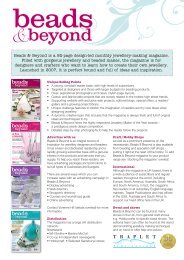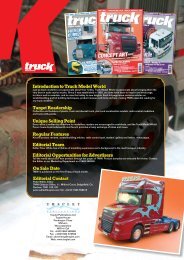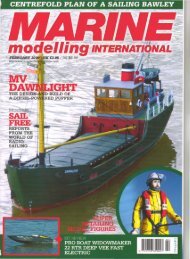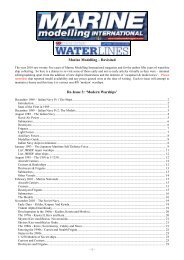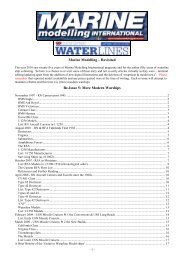Marine Modelling â Revisited Re-Issue 2: 'Foreign Warships'
Marine Modelling â Revisited Re-Issue 2: 'Foreign Warships'
Marine Modelling â Revisited Re-Issue 2: 'Foreign Warships'
You also want an ePaper? Increase the reach of your titles
YUMPU automatically turns print PDFs into web optimized ePapers that Google loves.
with displacement increasing to about 39,000 tons. Mutsu was lost accidentally in June 1943 when one of her magazines<br />
exploded, the precise reason not known. Nagato served throughout the war until January 1945, surviving a torpedo hit from<br />
the US submarine Skate in December 1943; by early 1945 she was moored at Yokosuka with her funnel and mainmast<br />
removed and falling into American hands at war’s end was eventually sunk during Atomic bomb tests in 1946.<br />
The Yamato class were intended to overcome American numerical superiority by means of five (possibly seven) superbattleships,<br />
equipped with the most heavy guns and armour yet, but still able to sustain 30 knots. Work on the design was<br />
initiated in 1934 and progressing steadily through many iterations the first pair - Yamato and Musashi - were laid down in<br />
1937 and 1938 respectively, followed a further two - Shinano and hull number ‘111’ in 1940. Yamato was completed in<br />
December 1941 and on 64,000 tons (69,988 full load) carried nine 18.1” guns (3 triples), twelve 6.1”, twelve 5” and 28<br />
light AA guns, with a maximum speed of 27 knots, 3 less than the original design aim. Two catapults were fitted aft and six<br />
aircraft could be carried. Musashi was completed in August 1942 although work on the next two was suspended at the<br />
outbreak of war. A short conflict was envisaged and it was considered that valuable ship building resources were best used<br />
elsewhere. After the Battle of Midway, it was decided to complete the Shinano as an aircraft carrier - this was<br />
accomplished by November 1944 but that same month whilst on her first trials cruise she was sunk by the US submarine<br />
Archerfish. Yamato and Musashi were both modified during the war with the wing 6.1” turrets removed in late 1943 and<br />
considerably more light AA added; Yamato alone received a further six 5” twins. Both were lost to US air attack, Musashi<br />
in October 1944 and her sistership the following April. Hull ‘111’ was broken up 30% complete and no further vessels laid<br />
down. Super-battleships they were, but no match for air power.<br />
The Japanese developed a number of other designs for the 8-8 programme and two 38,000 ton battleships of the Kaga class<br />
were ordered in 1918. These ships were to be 760 feet overall, speed 26 kts with ten 16" guns in twin turrets. Both Kaga<br />
and sister ship Tosa were under construction when the 1922 Washington Treaty came into force and the former was<br />
completed as an aircraft<br />
carrier and the latter<br />
sunk as a target. Four<br />
high speed battlecruisers<br />
of the Amagi class were<br />
ordered in 1919/20 -<br />
Amagi and Akagi were<br />
the first to be laid down<br />
although again the latter<br />
Neptun IJNS Yamato<br />
was<br />
finally<br />
commissioned as a<br />
carrier. Amagi was<br />
severely damaged in an<br />
earthquake in 1923 and<br />
subsequently scrapped. These particular ships are mentioned because Superior have released models of both Tosa and<br />
Amagi as they might have been completed. The final projected type to be produced as a waterline is a 32,000 ton<br />
battlecruiser version of the Yamato class ultimately called type B-65. These ships were very similar in profile to their big<br />
sisters and were first muted in 1940 as a 12.2" armed vessel with the design name B-64. In 1942 the design was upgraded<br />
to incorporate a new 14.2" gun, nominally to counter the American Alaska class battlecruisers, and re-named B65.<br />
MAY 1996 BATTLESHIPS OF THE WORLD PART 1<br />
This issue returns to a Naval theme by surveying what are loosely termed Battleships of the World. With vessels of the<br />
British & German Navies covered in earlier articles and the United States & Imperial Japanese Navies requiring dedicated<br />
pieces, the intention here is to look at all remaining dreadnought battleships, with the emphasis on completed rather then<br />
projected ships. For the latter please refer to the October and November 1992 magazines.<br />
Firstly a last word, for the moment at least, on colour schemes for the Ensign series of merchant ships concerns RE9 Kyle<br />
Rhea. The prefix Kyle suggested incorrectly that this was Monroe Brothers ship - in fact when named Kyle <strong>Re</strong>a (i.e. 1935<br />
to 1955) she was owned by R. Cameron & Co. of Glasgow and from 1940 by a Mrs E. Cubbin from Douglas, Isle of Man.<br />
The ship was completed in 1921 as the Tod Head for A. F. Henry & MacGregor Ltd at which time her colour scheme<br />
would have been black hull, red boot topping, buff masts and upperworks and black funnel with white bands. She was<br />
stranded at Peterhead, Aberdeenshire during a gale in 1929 and subsequently purchased, refloated and repaired by<br />
Grangemouth Dockyard Co. Ltd. before passing to Camerons in 1931. This change of ownership would have seen the<br />
funnel bands replaced by a red C but other colour details are not known. In 1955 she was bought by Ramsey SS Co. Ltd. of<br />
Douglas, re-named Ben Maye and painted broadly as follows: black hull and vents, red boot topping, buff masts and<br />
superstructure, white boats and black funnel with broad red band containing a white Maltese cross. The Ben Maye was<br />
finally broken up in 1964. The Kyle <strong>Re</strong>a colours given in the last Waterlines were those of Monroe Brothers who did own<br />
vessels prefixed Kyle but not this particular ship. My thanks to readers Jim McKeown and Brian Miller for the above<br />
information - I think I’ll stick to warships in future!<br />
- 6 -



